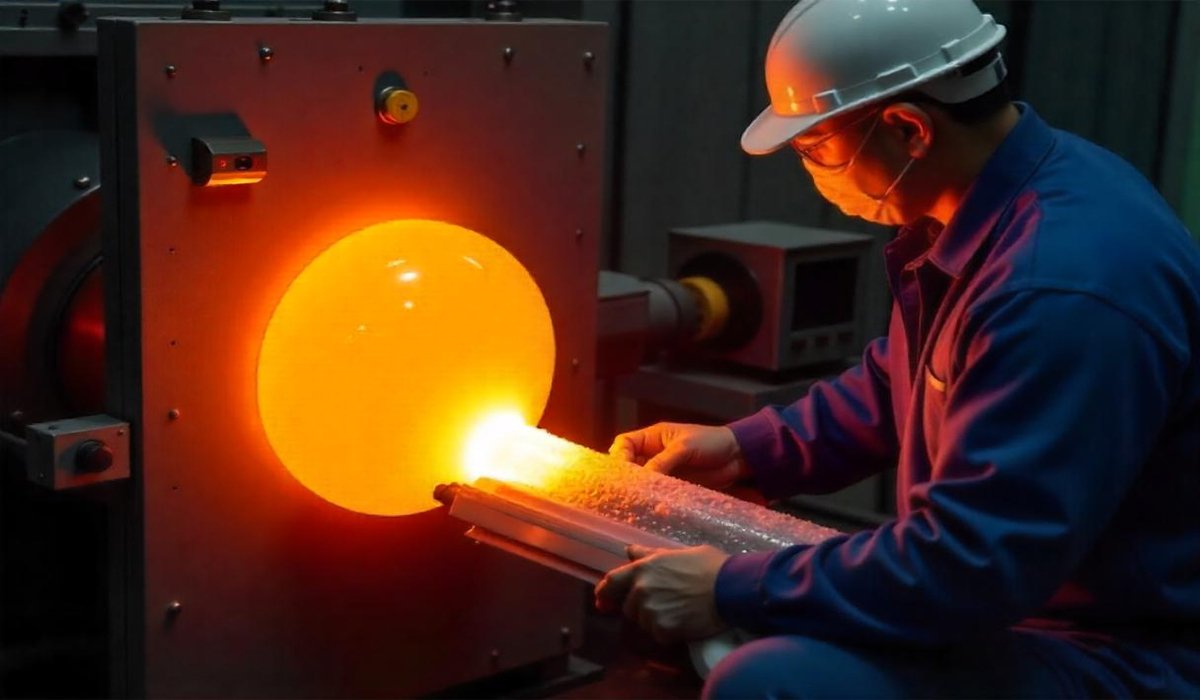Ever stopped to wonder how that roll of cling wrap in your kitchen drawer got so perfectly thin and strong? Or how giant plastic bags hold tons of material without bursting? It feels almost like magic, right? Well, step into the world of plastic film manufacturing, and you’ll find one unsung hero quietly orchestrating the whole show: the blow up ratio (BUR). It’s the secret sauce, the hidden dial, the make-or-break number that determines whether your film is a flimsy flop or a durable superstar. Getting this ratio right isn’t just technical jargon; it’s the difference between profit and scrap for manufacturers. Let’s pull back the curtain!
What Exactly IS Blow Up Ratio? (No Dynamite Involved!)
Think of it like blowing up a balloon, but with molten plastic instead of air. In a process called blown film extrusion, plastic pellets are melted and pushed through a circular die, forming a thick, hollow tube. Air is blown into the center of this tube, inflating it like a giant, hot bubble. The blow up ratio is simply this:
BUR = Final Bubble Diameter / Die Diameter
It’s a measure of how much you’ve stretched the molten plastic sideways as it inflates. If your die opening is 10 cm wide, and you inflate the bubble to 40 cm in diameter, your BUR is 40 / 10 = 4:1. Simple math, massive consequences!
Why Does This Little Ratio Matter So Much?
Why fuss over a simple division problem? Because the blow up ratio directly controls three critical properties of your plastic film:
- Film Thickness: Higher BUR stretches the plastic more, making the film thinner. Lower BUR means less sideways stretch and thicker film. It’s like pulling taffy – the more you pull, the thinner it gets.
- Strength & Toughness: Stretching the plastic molecules aligns them in the direction of the stretch (circumferential direction). This generally makes the film stronger around the bubble but can make it weaker along the length (machine direction). Finding the right BUR balance is key for overall toughness. Imagine weaving fabric – the direction of the threads matters for strength!
- Optical Clarity: Higher BUR can lead to better clarity because the stretching helps refine the crystal structure of certain plastics. Lower BUR might result in hazier film. Think of stretching plastic wrap tight over a bowl – it gets clearer.
- Output & Stability: Too high a BUR can make the bubble unstable and wobbly, leading to breaks and downtime. Too low might limit how fast you can produce film effectively.
Calculating Your Blow Up Ratio: It’s Easier Than You Think!
No advanced degree required! You really just need two measurements:
- Die Diameter (Dd): This is the fixed diameter of the circular opening the molten plastic comes out of. It’s set by your equipment. Measure it accurately!
- Bubble Diameter (Db): This is the diameter of the inflated bubble at the freeze line (where the plastic solidifies). This is measured after inflation. Use a simple pi tape measure designed for pipes, or laser gauges for high precision.
Plug them into the formula:
BUR = Db / Dd
Example: Die Diameter = 15 cm, Bubble Diameter = 60 cm
BUR = 60 / 15 = 4:1
The Balancing Act: Choosing the Right Blow Up Ratio
There’s no single “perfect” BUR for everything. It’s a careful dance depending on:
- The Plastic Material (Resin): Polyethylene (LDPE, LLDPE, HDPE) often runs between 2:1 and 4:1. Polypropylene (PP) might go higher, up to 5:1 or even 6:1 for some applications. Nylon needs careful handling. Each material stretches differently when hot.
- Desired Film Thickness: Thinner films generally require higher BUR. Need a super thin produce bag? Higher BUR. Need a thick construction sheeting? Lower BUR.
- End-Use Requirements: A heavy-duty shipping sack needs different strength properties (balanced MD/TD strength) than a super clear bakery film (where optics are key).
- Machine Capabilities: How stable is your line? Can it handle a high, wobbly bubble?
Read also: Eco-Friendly Vaping: How Disposable Vapes Are Evolving
Here’s a quick look at how BUR choices impact the film:
| Feature | Higher Blow Up Ratio (e.g., 4:1) | Lower Blow Up Ratio (e.g., 2:1) |
| Film Thickness | Thinner | Thicker |
| Transverse Direction (TD) Strength | Higher | Lower |
| Machine Direction (MD) Strength | Lower | Higher |
| Optical Clarity | Generally Better | Generally Poorer |
| Bubble Stability | More Challenging | More Stable |
| Typical Uses | Thin bags, wraps, high-clarity film | Heavy-duty sacks, thick liners, tubing |
Pro Tips for Mastering Your Blow Up Ratio
Want to sound like a seasoned pro on the production floor? Keep these nuggets in mind:
- Measure Consistently: Always measure the bubble diameter at the freeze line height. Moving up or down the bubble gives different, inaccurate readings.
- Stability is King: If your bubble looks like a drunken jellyfish (wobbling, surging, collapsing), your BUR is probably too high for the conditions (resin, melt temp, line speed, cooling). Dial it back slightly.
- It’s Not Just BUR: Remember, BUR works hand-in-hand with Draw Down Ratio (DDR), which is the stretching happening in the machine direction (lengthwise). Think of BUR as the sideways stretch and DDR as the lengthwise stretch. You need to balance both for optimal film properties. DDR = Die Gap / Final Film Gauge.
- Start With Resin Guidelines: Your resin supplier provides technical data sheets. These usually suggest a target range for BUR as a starting point for that specific material. Don’t ignore this free advice!
- Small Changes Matter: Adjusting BUR isn’t about giant leaps. Tweaking it by 0.1 or 0.2 can sometimes make a noticeable difference in stability or properties. Be patient and observant.
- Track Your Settings: Log your BUR, DDR, melt temperatures, line speed, cooling settings, and the resulting film properties (thickness, strength tests, appearance) for every run. This history is gold for troubleshooting and optimizing future jobs. Major players like Dow Chemical or ExxonMobil emphasize this data-driven approach.
Common Blow Up Ratio Pitfalls (And How to Dodge Them)
Even the best stumble sometimes. Watch out for these frequent BUR blunders:
- Chasing Thickness Only with BUR: Need thinner film? Cranking only the BUR way up might give you thin film, but it could be weak, hazy, or cause constant breaks. Adjust line speed and DDR too! It’s a system.
- Ignoring Bubble Instability: “It’s holding… barely.” A shaky bubble is a disaster waiting to happen. It leads to uneven thickness (gauging problems), wrinkles, and breaks. Sacrifice a tiny bit of target BUR for rock-solid stability. Downtime costs way more.
- Forgetting the Material Matters: Trying to run Nylon at the same high BUR you use for LDPE is a recipe for tears (yours and the film’s). Respect the resin’s characteristics.
- Inaccurate Measurement: Measuring the bubble diameter inconsistently or in the wrong place (not at the freeze line) gives a false BUR reading, leading to confusion and poor adjustments. Garbage in, garbage out.
- Neglecting Cooling: How fast you cool the bubble affects crystallinity and properties. Aggressive cooling might let you run a slightly higher BUR than gentle cooling, but it can also introduce other issues. Cooling and BUR are partners.
5 Quick Takeaways to Blow Up Your Success (Pun Intended!)
Let’s boil it down to the essentials:
- BUR = Bubble Width / Die Width. It’s the sideways stretch factor.
- BUR Controls Thickness & Strength Balance. Higher = Thinner & Stronger around, but weaker lengthwise.
- Material is Key. Different plastics (PE, PP, Nylon) love different BUR ranges. Check the datasheet!
- Stability Trumps Theory. A stable bubble producing good film at BUR 3.7 is better than a wobbly mess at your “target” 4.0.
- Measure Right & Log Everything. Consistency and data are your best friends for perfecting the process.
Mastering the blow up ratio is like learning the secret handshake of blown film extrusion. It takes practice, observation, and a feel for the machine, but once you get it dialed in, you unlock consistent quality, fewer headaches, and less wasted material. It’s the quiet powerhouse behind so much of the plastic film we use every single day.
So, what’s your experience with the blow up ratio? Ever chased a wobbly bubble or been amazed at how a tiny BUR tweak fixed a big problem? Share your war stories or questions below – let’s get this conversation bubbling!
FAQs:
- Is a higher blow up ratio always better?
Nope! It depends entirely on the material and what properties you need. Higher BUR makes thinner film with more transverse strength but less machine direction strength and can cause instability. Balance is key. - What’s a typical blow up ratio for polyethylene bags?
For common grocery bags or trash bags (often LLDPE or LDPE), BUR typically ranges from 2.5:1 up to 4:1. Heavy-duty sacks might use a lower ratio. - How does blow up ratio affect film thickness?
Directly! A higher BUR stretches the molten plastic more sideways, resulting in thinner film. Lower BUR means less sideways stretch and thicker film. Think of it like pulling pizza dough. - Can I change the blow up ratio while the line is running?
Yes, absolutely! Operators adjust the amount of air inside the bubble to increase or decrease its diameter, changing the BUR on the fly. But do it gradually to avoid shocking the bubble and causing breaks. - What happens if my blow up ratio is too low?
Film will be thicker than intended. Machine Direction (MD) strength might be higher, but Transverse Direction (TD) strength will be lower. Output might also be limited. The film might also be hazier. - Is blow up ratio the only thing controlling film properties?
No way! It works closely with Draw Down Ratio (DDR – lengthwise stretch), melt temperature, cooling rate, and the resin itself. BUR is a major player, but it’s part of a team. - How do I measure bubble diameter accurately?
Use a Pi (π) tape designed for measuring pipe diameters. Ensure you measure at the freeze line (where the plastic solidifies) consistently. Laser gauges offer high precision for critical applications.
You may also like: Why Custom Plastic Tubing is Essential for Medical and Industrial Applications










